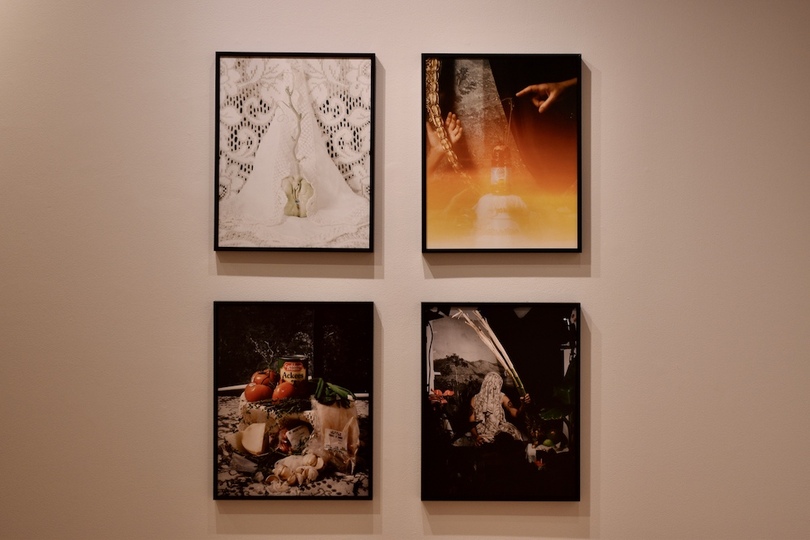Fruit, Caribbean identity inspire Samantha Box’s exhibit ‘Caribbean Dreams’

Anthony Alandt | Senior Staff Writer
Samantha Box is Jamaican-born and uses her cultural identity to portray her diasporic Caribbean history.
Get the latest Syracuse news delivered right to your inbox.
Subscribe to our newsletter here.
In 2018, Samantha Box stumbled upon a section in her local market with foods she hadn’t seen in a long time. She looked at rows and rows of Caribbean fruits, vegetables and apis, a salt fish that is part of a national Jamaican dish.
“When I was growing up, apis were almost forbidden in the U.S. They were very hard to find and very expensive,” Box said. “The states had this idea that they shouldn’t be eaten.”
Box was shocked to see how many different brands of apis were now available to her. She remembers reaching for one can with packaging that read “Caribbean Dream.”
“Whose dream is this? What is this referring to?” Box asked herself as she examined the can. She took that can home along with other Caribbean fruits and vegetables and began to craft the images that now make up the “Caribbean Dreams” exhibit, which will be on display at Light Work until Oct. 13.
Box is a Jamaican-born, Bronx-based photographer who portrays her diasporic Caribbean history and identity through vibrant still life artworks. Each photograph is a window into Box’s desire to uncover her Caribbean identity from as many angles as possible.
Daniel Boardman, the director at Light Work, a non-profit photography organization that supports underrepresented and emerging artists, was drawn to “Caribbean Dreams” because of Box’s creativity in combining her cultural and familial identity through unexpected objects.
“I feel a very close connection to the curiosity and experimentation that Sam has in her practice,” Boardman said. “She is so willing to take risks and follow this inner guiding voice for each piece. It’s something I really appreciate about her work.”
For roughly 30 years before “Caribbean Dreams,” Box focused on shooting documentary-style work of capturing raw accounts of New York City’s queer and trans youth of color.
For years, she photographed Sylvia’s Space, one of New York City’s only emergency shelters for homeless LGBTQ youth, and the Kiki Ballroom scene. But as time passed and members of the ballroom community began to document themselves from within, Box reflected on why she was taking these kinds of photos.
“I had this feeling that perhaps I wasn’t doing what I wanted to do in my work,” Box said. “Traditionally there is a loose narrative in documentary photography, but I didn’t have that.”

In 2015, Box applied to become a resident at Light Work where she sought to answer the questions she had about her practice.
Box said that she has always struggled with documentary photography because she doesn’t like collapsing a narrative of a story into one scene.
“I wanted to have an open-ended space where I could talk about things,” Box said. “So I left my residency at Light Work, still with all these questions, and went back to the city to teach.”
In the city, Box was teaching photography and trying to figure out what her next career steps were when suddenly her program was cut. Box was once again at a reckoning point with her career.
She ended up applying to the International School of Photography where she underwent a full-time intensive program that made it hard for Box to photograph New York City’s queer and trans population.
“I couldn’t really be out late on the streets capturing things anymore. I tried but kept on oversleeping,” Box said.
Box then turned to still life photography, which had always been relaxing, yet frustrating for her.
She moved to the Bronx, where she lived in a neighborhood with a strong Jamaican community. Box began to think about her relationship to the Caribbean and the types of food that are important to different cultures, and “Caribbean Dreams” was born.
“Present in all of Box’s constructions is her desire to see her Caribbean identity and history from as many angles as possible,” Light Work said on their website. “Each new generation of images both invites and prods the viewer to consider the recurring objects with a fresh perspective.”
When asked what emotion she would like to evoke from her audience, Box made it clear that her work is solely for herself. And while Caribbean people may recognize and connect with aspects of her photos, there are so many different cultures and familial identities in the Caribbean that Box didn’t want to generalize.
“People may not know the specific fruits or the history within each photo,” Box said. “But I hope they understand there’s a deeply personal narrative, landscape and depth of storytelling in the work.”





